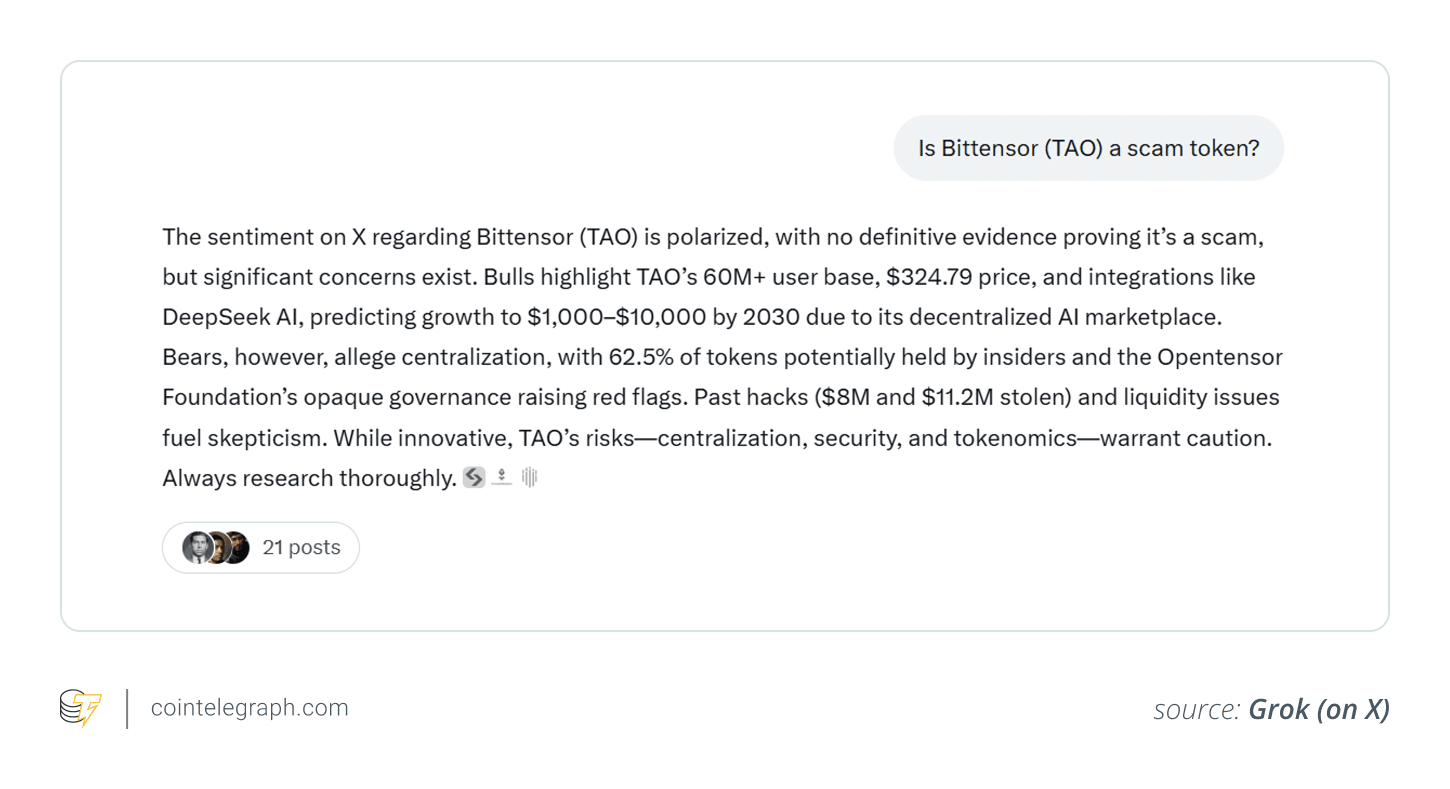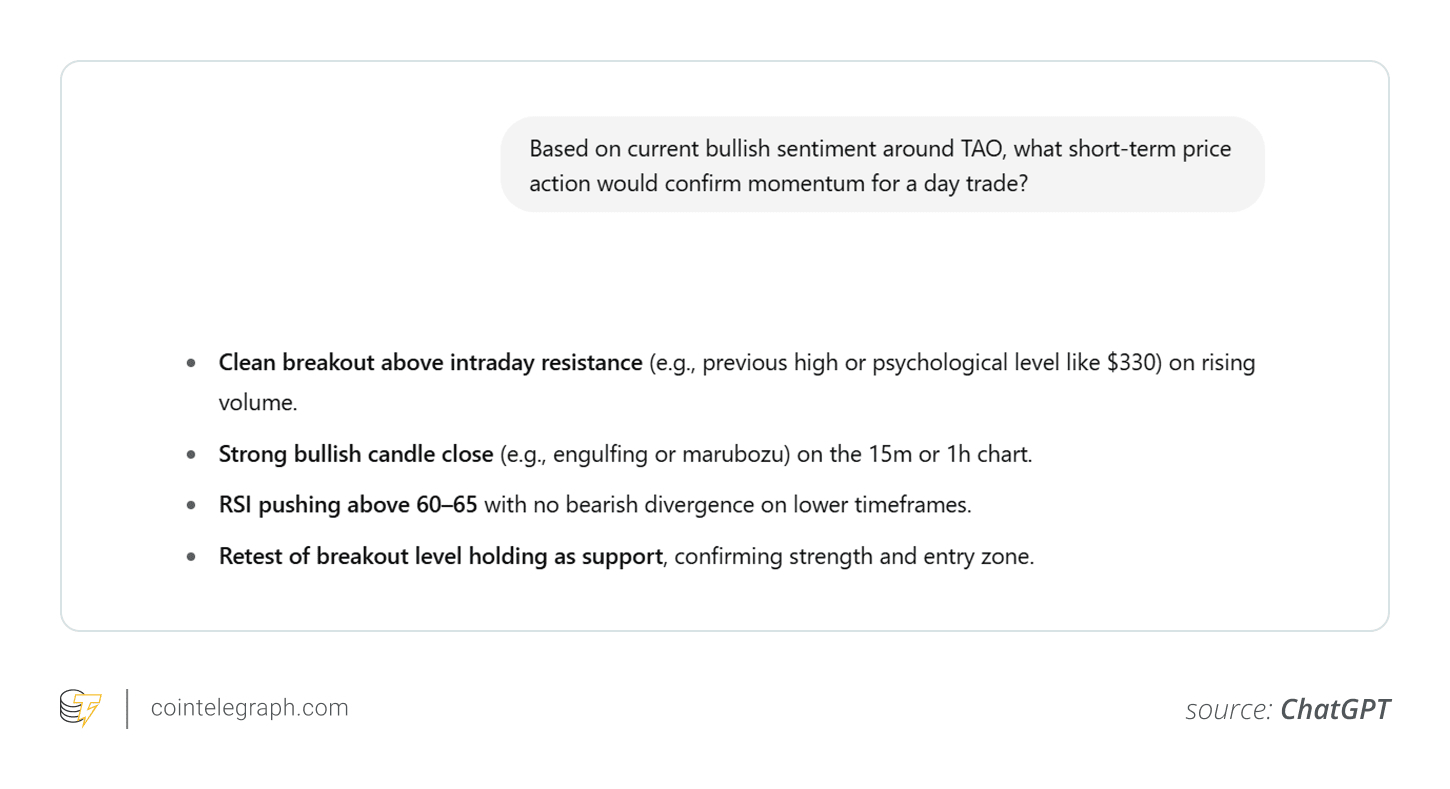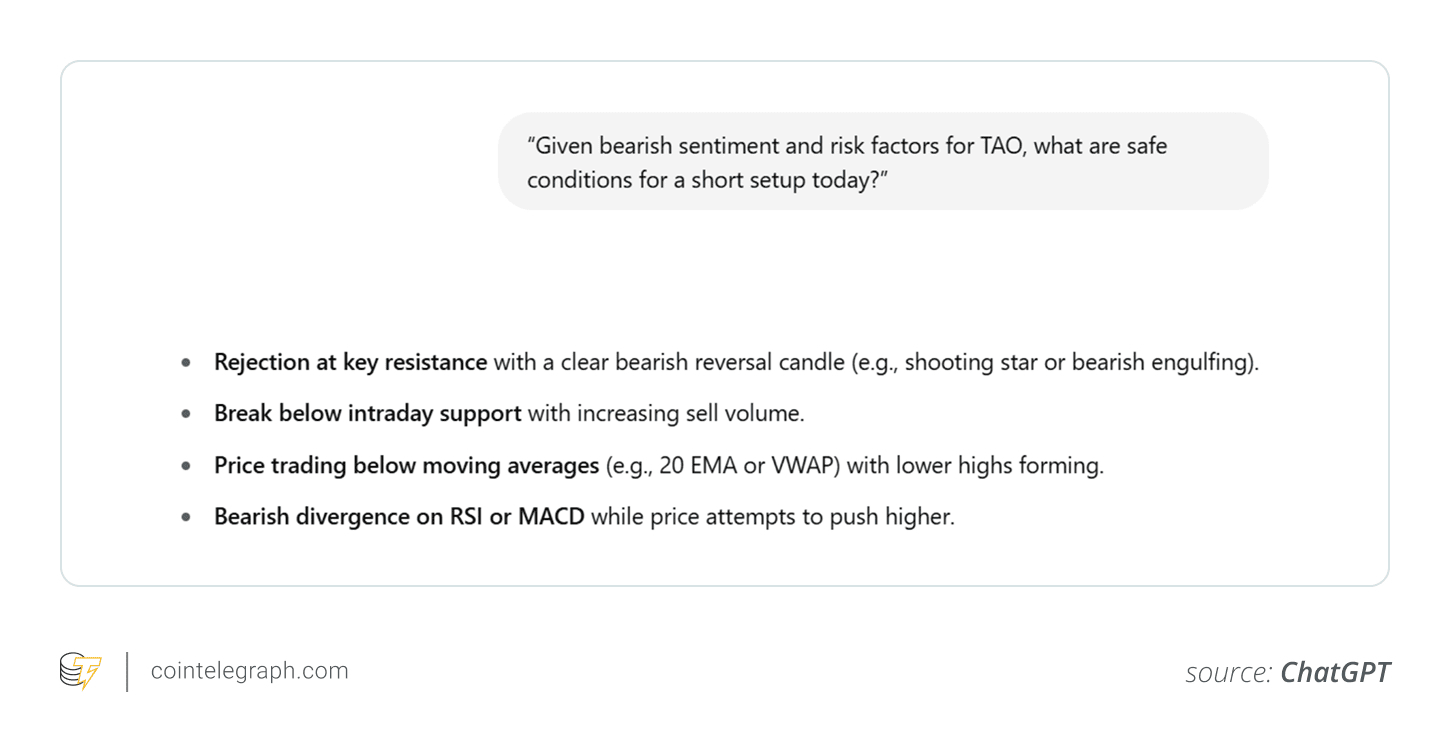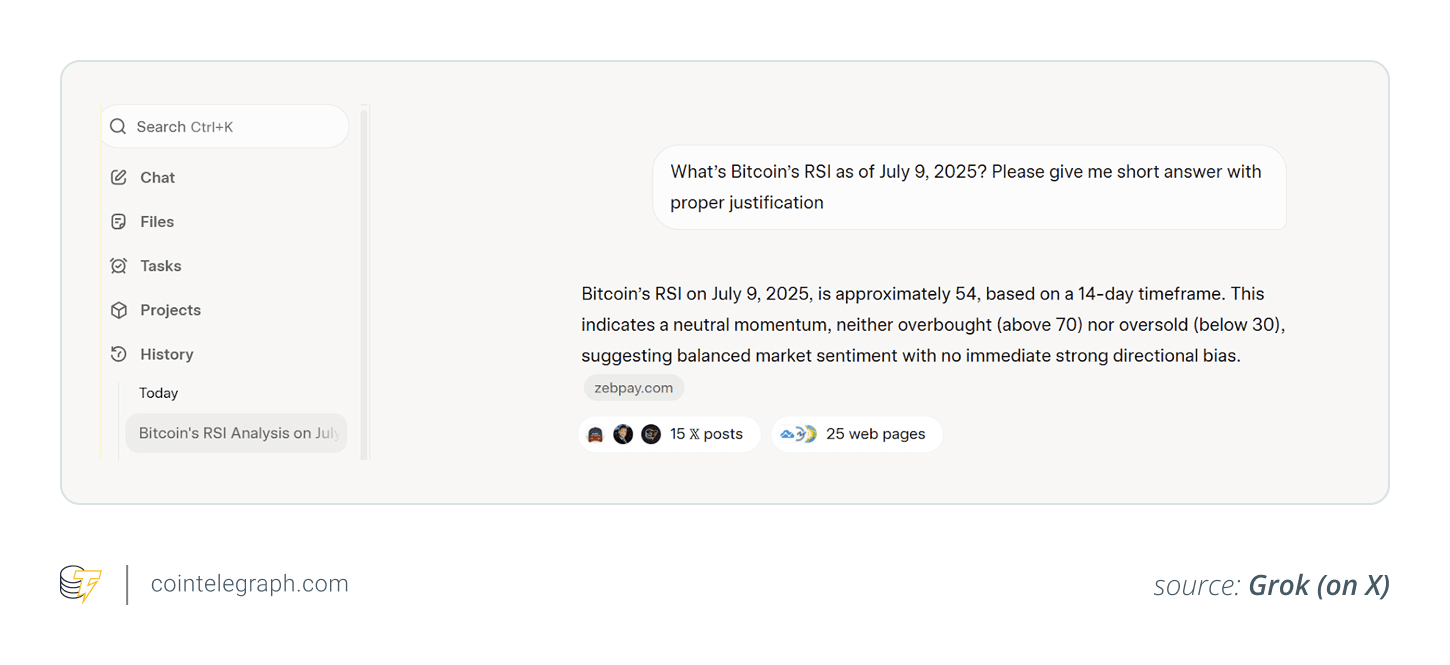AI tools like Grok and ChatGPT are changing traders' approaches to cryptocurrency day trading by tracking sentiment changes in real-time and turning them into structured trading plans.
Key takeaways
Grok detects spikes in sentiment from X in real-time that often precede short-term price movements, but not all spikes are reliable.
ChatGPT transforms these signals into trading plans, helping to structure entries, exits, and risk parameters based on technical and fundamental context.
AI tools do not replace judgment. You will learn to add volume filters, whale flow checks, and confirmation rules to avoid emotional or manipulative trades.
Journaling after trades with ChatGPT will help you increase your win percentage, avoid repeat mistakes, and build a system based on reflection rather than just reaction.
Day trading rules are changing rapidly. What once required hours of analysis can now happen in seconds thanks to a new class of artificial intelligence tools.
traders discreetly use platforms like ChatGPT and Grok to gain an edge in the around-the-clock world of cryptocurrencies, sometimes in ways that you might not expect.
What is cryptocurrency day trading?
Cryptocurrency day trading involves opening and closing trades within a single day, sometimes within minutes, to profit from small but rapid price changes. It is a short-term business focused on momentum, volume, and speed rather than long-term holding.
Here’s how it works:
1. Setting up the setup. Traders work on charts from 5 minutes to 1 hour, tracking breakout patterns. Indicators like RSI, MACD, or sudden volume spikes often confirm these moves.
2. Definition of trading
Entry: Just above the breakout or resistance on the chart.
Stop-loss: Just below the recent support level or breakout.
Take profit: based on resistance zones, Fibonacci targets, or a fixed profit-to-risk ratio (e.g., 2:1 or 3:1)
Intraday traders aim to profit from short-term intraday price movements, typically opening and closing positions within a single trading day. This trading style relies heavily on technical analysis, discipline, and strict risk management.
What distinguishes cryptocurrency day trading?
How to day trade cryptocurrency using ChatGPT and Grok
Artificial intelligence tools like Grok and ChatGPT are changing traders' approaches to cryptocurrency day trading by tracking sentiment changes in real-time and turning them into structured trading plans.
Key takeaways
Grok detects spikes in sentiment from X in real-time that often precede short-term price movements, but not all spikes are reliable.
ChatGPT transforms these signals into trading plans, helping to structure entries, exits, and risk parameters based on technical and fundamental context.
AI tools do not replace judgment. You will learn to add volume filters, whale flow checks, and confirmation rules to avoid emotional or manipulative trades.
Journaling after trades with ChatGPT will help you increase your win percentage, avoid repeat mistakes, and build a system based on reflection rather than just reaction.
Day trading rules are changing rapidly. What once required hours of analysis can now happen in seconds thanks to a new class of artificial intelligence tools.
This article explains how traders discreetly use platforms like ChatGPT and Grok to gain an edge in the around-the-clock world of cryptocurrencies, sometimes in ways that you might not expect.
What is cryptocurrency day trading?
Cryptocurrency day trading involves opening and closing trades within a single day, sometimes within minutes, to profit from small but rapid price changes. It is a short-term business focused on momentum, volume, and speed rather than long-term holding.
Here’s how it works:
Setting up the setup. Traders work on charts from 5 minutes to 1 hour, tracking breakout patterns. Indicators like RSI, MACD, or sudden volume spikes often confirm these moves.
Definition of trading
Entry: Just above the breakout or resistance on the chart.
Stop-loss: Just below the recent support level or breakout.
Take profit: based on resistance zones, Fibonacci targets, or a fixed profit-to-risk ratio (e.g., 2:1 or 3:1).
Intraday traders aim to profit from short-term intraday price movements, typically opening and closing positions within a single trading day. This trading style relies heavily on technical analysis, discipline, and strict risk management.
What distinguishes cryptocurrency day trading?
Cryptocurrency markets are much more volatile and operate 24/7. Order books can be thin, and social media sentiment plays a huge role. This is where tools like Grok (for early sentiment alerts) and ChatGPT (for structuring schemes) are important; they help filter out noise and make decisions faster.
For instance, in early June 2025, Solana's activity in DeFi surged, and its total value locked (TVL) surpassed $9 billion, indicating real momentum. Traders could use Grok for early trend change detection, and ChatGPT for structuring trading settings, including entry planning, stop-loss placement, and profit target metrics.
How to identify trending opportunities for cryptocurrency day trading using Grok
Grok, available in X apps (x.com or X), grok.com, or Grok, helps traders track cryptocurrency trends through sentiment analysis, market data, and real-time news.
Whether you are looking for breakthrough tokens, technical entries, or early fraud alerts, Grok can help you quickly and accurately identify opportunities.
Here are three actionable ways to use Grok in your cryptocurrency day trading strategy:
1. Track sentiment around token X to boost its popularity
How it works: Grok scans X posts for spikes in token mentions or sentiment changes, signaling potential growth (for example, a 7-fold increase in $WIF mentions often predicts a rally).
Access:
Free: 10 messages/2 hours, three image analyses/day. Suitable for one or two daily token checks; may miss rapidly changing news.
Paid plans: X Premium ($8/month, $84/year), Premium+ ($16/month, $168/year), or SuperGrok (pricing available at https://x.ai/grok) allow for frequent inquiries. Premium+ Think mode enhances sentiment analysis.
Example prompt:
"What are the sentiments regarding coin X Pi?"
Here is what came out:

Grok reports mixed sentiments regarding Pi Coin: bulls see potential of $1–$1.25 with a strong community and Chainlink growth, while bears warn of a drop to $0.40 due to unlocks, centralization, and KYC issues.
2. Check technical indicators (through Grok.com)
How it works: Grok pulls real-time data (e.g., RSI) from sources like CoinMarketCap for instant trade conclusions (e.g., BTC RSI at 62 signals bullish momentum)
Access:
Free: 10 messages/2 hours, limit of 1–2 indicator checks per day; suitable for swing traders.
Paid: higher quotas allow for multiple checks (e.g., BTC, ETH hourly). Premium+ DeepSearch accelerates web TA.
Example prompt: "What is Bitcoin's RSI as of July 9, 2025? Please give me a brief answer with justification."
According to Grok, Bitcoin's RSI on July 9, 2025, was 54 points on a 14-day timeframe, indicating neutral momentum (see image below).
3. Check the legitimacy of the token
How it works: Grok matches user sentiments X and web data (such as official documents, community reviews) to identify potential fraud schemes or assess fundamental indicators. This is critically important for meme coins like $GROK, which has been associated with fraud suspicions.
Access:
Free: Request limits may slow down checking multiple tokens.
Paid: higher quotas allow for checking multiple tokens or conducting deeper analysis (e.g., "Check $GROK contract for red flags").
Example prompt: "Is Bittensor (TAO) a fraudulent token?"
Based on the above, Grok reports mixed sentiments regarding Bittensor (TAO): growth theory proponents see AI market growth potential of $1,000–10,000 by 2030, while growth theory opponents point to centralization, insider token control, hacks, and governance issues, urging caution.

Day trading analytics using Grok
Sentiment spikes often precede price changes; monitoring mentions of X can help identify early token dynamics.
Social media noise is a significant signal, especially in meme coin trading, but should be combined with other indicators.
RSI and other technical tools provide context, and combining sentiment with real-time indicators improves timing and trade setup.
Grok can identify mixed sentiments, helping traders see both growth potential and downside risks (e.g., Pi Coin or TAO).
Fundamental checks are crucial; Grok's fraud detection system identifies risks such as centralization, unlocks, or governance issues.
Real-time data allows for quick decision-making, which is particularly valuable in the dynamic conditions of day trading.
Structured prompts help refine trading plans; Grok can assist in formulating entry, stop-loss, and exit strategies.
Grok's limitations (and why they matter)
The free tier has strict limits on frequency and volume of requests.
Sentiment analysis can lead to misinterpretation of tone or a lack of ability to react in real-time during highly volatile events.
No direct trading integration; this is an analytical tool, not a trading platform.
The quality of prompts affects the outcome; vague or generic prompts can lead to unhelpful results.
May not track all warning signals, especially in the case of completely new or obscure tokens with limited data.
Delay in data or indicator updates can affect trade timing on highly volatile markets.
How to use ChatGPT to structure cryptocurrency trades
Once you have identified a reliable signal using Grok, the next step is to structure your trade. ChatGPT will be your powerful assistant, helping you identify entry points, stops, exits, and even analyze trades after they are completed.
Using the TAO example discussed above, here’s how ChatGPT can help:
Example 1: Trade cautiously on a bullish trend
Use case: Grok's results highlight optimistic sentiment driven by the TAO user base, integration, and long-term growth potential.
How to trade (using ChatGPT):
Ask ChatGPT: "Given the current optimistic sentiment around TAO, what short-term price movement will confirm momentum for day trading?"

Example 2: Rally fade due to 'bearish' risk factors
Use case: Grok points out serious issues such as token centralization, transparency of governance, and past hacks.
How to trade (using ChatGPT):
Ask ChatGPT:
"Given the bearish sentiment and risk factors for TAO, what conditions are safe for a short position today?"

AI limitations in trading: what it cannot do yet
AI is changing how traders work, but it is not a crystal ball. Tools like Grok and ChatGPT can analyze sentiment, sift through market noise, and help structure plans faster than any human. But speed is not the same as confidence, and automation does not eliminate risk.
The reality is: AI is only as good as the data it has and the person using it.
Grok can catch a spike in sentiment but cannot always determine if it is a genuine impulse or coordinated hype. ChatGPT can help craft the perfect trading plan, but it cannot pull the trigger, control slippage, or feel market movement in real-time.
AI has no personal stake in the game.
It does not feel a sense of missed opportunity, panic, or greed. This is both its strength and weakness. Without human judgment, AI tools can be just as misleading as they can be guiding. Inaccurate prompts, outdated data, or over-reliance on sentiment can turn a good idea into a bad trade. And while they can analyze past performance, they do not learn from experience like an experienced trader unless you build that cycle yourself.
So yes, AI is a powerful system. But it is not infallible.
And this certainly will not replace strategy, discipline, or risk management.
Use it as an advantage, not a crutch.
Because ultimately every trade comes down to you.


